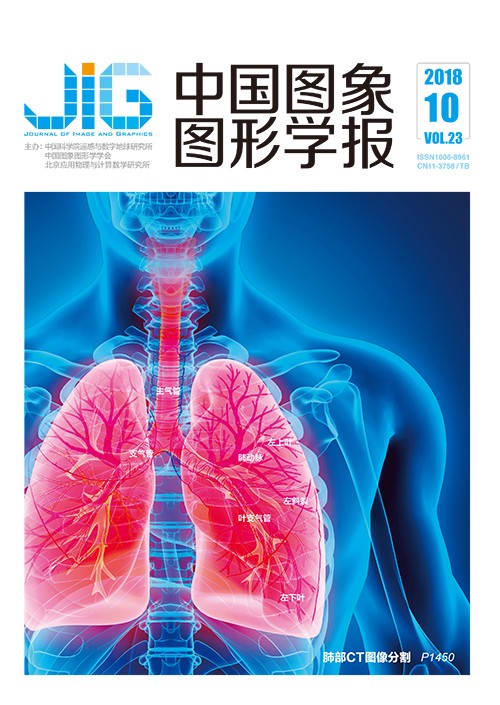
分类与分割相结合的JPEG图像隐写分析
汪然1,2, 薛小燕3, 平西建2,4, 牛少彰1, 张涛2(1.北京邮电大学计算机学院, 北京 100876;2.信息工程大学信息系统工程学院, 郑州 450001;3.江南计算技术研究所, 无锡 214083;4.郑州升达经贸管理学院, 郑州 451191) 摘 要
目的 隐写分析研究现状表明,与秘密信息的嵌入过程相比,图像内容和统计特性差异对隐写检测特征分布会造成更大的影响,这导致图像隐写分析成为了一个"相同类内特征分布分散、不同类间特征混淆严重"的分类问题。针对此问题,提出了一种更加有效的JPEG图像隐写检测模型。方法 通过对隐写检测常用的分类器进行分析,从降低隐写检测特征类内离散度的角度入手,将基于图像内容复杂度的预分类和图像分割相结合,根据图像内容复杂度对图像进行分类、分割,然后分别对每一类子图像提取高维富模型隐写检测特征,构建分类器进行训练和测试,并通过加权融合得到最终的检测结果。结果 在实验部分,对具有代表性的隐写检测特征集提取了两类可分性判据,对本文算法的各类别、区域所提取特征的可分性均得到明显提高,证明了模型的有效性。同时在训练、测试图像库匹配和不匹配的情况下,对算法进行了二分类测试,并与其他算法进行了性能比较,本文算法的检测性能均有所提高,性能提升最高接近10%。结论 本文算法能够有效提高隐写检测性能,尤其是在训练、测试图像库统计特性不匹配的情况下,本文算法性能提升更加明显,更适合于实际复杂网络下的应用。
关键词
Steganalysis of JPEG images based on image classification and segmentation
Wang Ran1,2, Xue Xiaoyan3, Ping Xijian2,4, Niu Shaozhang1, Zhang Tao2(1.Beijing University of Posts and Telecommunications, Beijing 100876, China;2.Zhengzhou Information Science and Technology Institute, Zhengzhou 450001, China;3.Jiangnan Institute of Computing Technology, Wuxi 214083, China;4.Zhengzhou Shengda University of Economics, Business & Management, Zhengzhou 451191, China) Abstract
Objective Image steganalysis is the opposite technology of steganography;it aims to detect,extract,restore,and destroy secret messages embedded in cover images.As an important technical tool for image information security,image steganalysis has become popular in multimedia information security to researchers all over the world.The basic concept of the current image steganalysis is to analyze the embedding mechanism and the statistical changes in image data caused by embedding secret messages.Images steganalysis overcomes the binary classification problem by using the cover and stego images of two image categories.The performance of steganalysis methods depends on feature extraction,and steganalysis features are expected to have small within-class scatter distances and big between-class scatter distances.However,embedded changes are not only correlated with steganography methods but also with image content and local statistical characteristics.The changes in steganalysis features caused by secret embedding are subtle,especially when the embedding ratio is low.The contents and statistical characteristics of images have a stronger impact on the distribution of steganalysis features than the embedding process.Thus,the steganalysis features of cover and stego images are inseparable,a scenario that can be attributed to the differences in image statistical characteristics.Consequently,image steganalysis becomes a classification problem with large within-class and small between-class scatter distances.To solve this problem,a new steganalysis framework for JPEG images,which aims to reduce the within-class scatter distances,is proposed.Method The secret messages after embedding will have different effects on the characteristics of images with different content complexities,while the steganalysis features of the images with the same content complexity are similar.This study on image steganalysis focuses on reducing the differences of image statistical characteristics caused by various contents and processing methods.The motivation of the new model is introduced by analyzing the Fisher linear discriminant analysis,which is the basis of the ensemble classifier,the most used one in steganalysis applications,and a new steganalysis model of JPEG images based on image classification and segmentation is proposed.We define a content complexity evaluation feature for each image,and the given images are first classified according to the content.Thus,the images classified to the same sub-class will have a closer content complexity.Then,each image is segmented to several sub-images according to the evaluated texture features and the complexity of each sub-block.During segmentation,we first categorize the image blocks according to texture complexity,and then amalgamate the adjacent block categories.After the combined classification and segmentation process,the content texture of the same class of image regions is more similar,and the steganalysis features are more centralized.The steganalysis features are extracted separately from each subset with the same or close texture complexity to build a classifier.When deciding which steganalysis feature set to extract,we mainly consider the performance.In our prior work,we found that when extracting a steganalysis feature set with low dimension,the performance of the method based on classification or segmentation can be obviously improved.However,when extracting high-dimensional steganalysis features,such as JPEG rich model (JRM),the performance is unsatisfactory because the rich model is based on the residual of the given image,and it can eliminate the effect of image content.The JRM feature set is sensitive to subtle image details,and the steganalysis result is good.However,we still extract the JRM feature set,which is the most representative high-dimensional feature set in the JPEG domain,to prove the validity of the proposed model.In the testing phase,the steganalysis features of each segmented sub-image in each sub-class are sent to the corresponding classifier.The final steganalysis result is obtained through the weighted fusing process.Result In the experiment,we compute two kinds of separability criteria of the tested steganalysis feature set,including the separability criterion based on the within-and between-class distances and the Bhattacharyya distances.The Bhattacharyya distance is one of the most used separability criteria on the basis of the probability density of classified samples.Both separability criteria of the proposed method are obviously improved,which means that the proposed classified and segmentation-based steganalysis features can be more easily categorized,thereby verifying the validity of the proposed steganalysis model.We also compare the classification performance of the proposed method and the prior work in various experimental circumstances,including the use of the same and different training and testing image databases.We compute the detection results for the original feature set,the features extracted from the classified image and the segmented image,and the image combined classification and segmentation.Experimental results show that in both circumstances,the combined classification and segmentation process can effectively improve the performance by up to 10%.The improvement considerably higher when the training and testing images have different statistical features,which implies that the proposed method is suitable for practical application on images from the Internet with considerable diversity in sources,processing methods,and contents.Conclusion In this paper,a new steganalysis model for JPEG images is proposed.The differences in image statistical characteristics caused by various contents and processing methods are reduced by image classification and segmentation.The JRM feature set was extracted.The theoretical analysis of and the experimental results for several diverse image databases and circumstances demonstrate the validity of the framework.When a considerable diversity in image sources and contents exists,such as different training and testing images,the performance improvement of the proposed method is obvious,indicating that the performance of the proposed method does not depending highly on image content.Furthermore,the proposed steganalysis model is suitable for practical application in complex network environments.
Keywords
steganalysis image statistical characteristics image classification image segmentation weighted fusing
|



 中国图象图形学报 │ 京ICP备05080539号-4 │ 本系统由
中国图象图形学报 │ 京ICP备05080539号-4 │ 本系统由